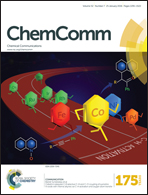[(ClImDipp)P![[double bond, length as m-dash]](https://www.rsc.org/images/entities/char_e001.gif) P(Dipp)][GaCl4]: a polarized, cationic diphosphene†
P(Dipp)][GaCl4]: a polarized, cationic diphosphene†
Abstract
The reaction of the neutral diphosphanide [(ClImDipp)P–P(Cl)(Dipp)] (6) (ClImDipp = 4,5-dichloro-1,3-bis(Dipp)-imidazol-2-yl; Dipp = 2,6-di-iso-propylphenyl) with methyl triflate (MeOTf) leads to the formation of cationic diphosphane [(ClImDipp)(Me)P–P(Cl)(Dipp)]+ (8+) in a stereoselective methylation. In contrast, reacting 6 with the Lewis acid GaCl3 yields cationic diphosphene [(ClImDipp)P![[double bond, length as m-dash]](https://www.rsc.org/images/entities/char_e001.gif) P(Dipp)]+ (7+), which is explained by a low P–Cl bond dissociation energy. The significantly polarized P
P(Dipp)]+ (7+), which is explained by a low P–Cl bond dissociation energy. The significantly polarized P![[double bond, length as m-dash]](https://www.rsc.org/images/entities/char_e001.gif) P double bond in 7+ allows for its utilization as an acceptor for nucleophiles – the reaction with Cl− regenerates diphosphanide 6 and the reaction with PMe3 gives cation [(ClImDipp)P–P(PMe3)(Dipp)] (9+). In depth DFT investigation provides detailed insights into the bonding situation of the reported compounds.
P double bond in 7+ allows for its utilization as an acceptor for nucleophiles – the reaction with Cl− regenerates diphosphanide 6 and the reaction with PMe3 gives cation [(ClImDipp)P–P(PMe3)(Dipp)] (9+). In depth DFT investigation provides detailed insights into the bonding situation of the reported compounds.
![Graphical abstract: [(ClImDipp)P [[double bond, length as m-dash]] P(Dipp)][GaCl4]: a polarized, cationic diphosphene](/en/Image/Get?imageInfo.ImageType=GA&imageInfo.ImageIdentifier.ManuscriptID=C5CC08248J&imageInfo.ImageIdentifier.Year=2016)

 Please wait while we load your content...
Please wait while we load your content...
![[double bond, length as m-dash]](https://www.rsc.org/images/entities/h2_char_e001.gif) P(Dipp)][GaCl4]: a polarized, cationic diphosphene
P(Dipp)][GaCl4]: a polarized, cationic diphosphene